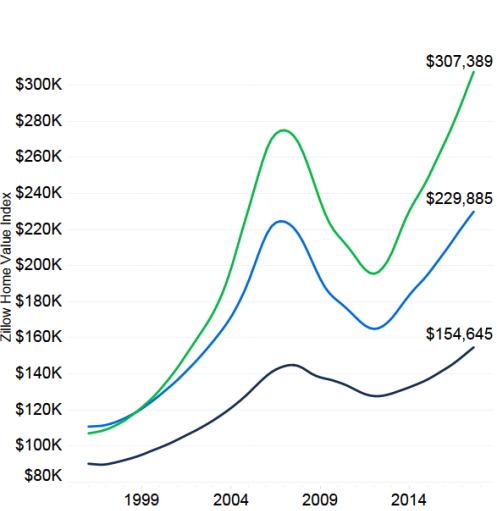The premium that households pay to live in cities relative to suburbs and rural areas continues to increase
Three years ago, we introduced the term “Dow of cities.” It’s a riff on the Dow Jones Industrial Average (DJIA), which is a broad-based summary measure of stock market valuation. The idea behind the Dow of cities is that the relative prices that people pay for housing in cities compared to suburbs constitutes a powerful indicator of the value attached to urban living. Over the past couple of years, we’ve assembled data from a variety of sources tracking the growth of urban home values relative to suburban ones. Some data has come from Fitch Investment Advisers, other data was compiled by Columbia University economists Lena Edlund, Cecilia Machado, and Michaela Sviatchi.
Our latest take on the Dow of cities comes from Zillow. Zillow tracks home prices throughout the nation, and its economists regularly make presentations about the health and outlook for local real estate markets. Zillow principal economist Aaron Terrazas recently made such a presentation to the Virginia Beach Marketing Forum last month. The whole presentation is worth a look, but we were particularly taken by one chart in his slide deck, which we’ve reproduced in part here. It shows the average national price, measured by Zillow’s Home Value Index, of houses in urban areas (green), suburban areas (blue) and rural areas (black).

The data clearly show the inflation and collapse of the housing bubble a decade ago, and the recovery in house prices since then. (Nominal house prices have recovered to pre-bubble levels today). The Zillow data also confirm a trend we’ve consistently seen from other sources. Since the late 1990s urban home prices have grown faster than suburban ones. In the late 1990s, according to Zillow, urban and suburban homes commanded about the same price. Over the past 17 years, urban home prices have steadily pulled away from suburban ones, even as the housing bubble grew and deflated. Today, the typical urban home commands more than a $75,000 premium over the typical suburban home.
In an important sense, what this shows is that the past two decades have been a bull market for cities. City home values are now fully one-third higher than suburban ones. In stock market terms, a portfolio of urban housing has outperformed a portfolio of suburban housing. And meanwhile, the value of rural housing has fallen relative to cities, with the typical rural home being worth only a little over half as much as the typical urban home.
Underlying these trends is the growth of knowledge-based industries in cities and the growing demand for urban living. Households tend to have better economic prospects in cities because that’s where highly paid professional, technical and service jobs are growing. In addition, the desire for urban amenities, and for dense, interesting, walkable neighborhoods is also fueling the demand for urban living. Finally, as we’ve noted, there are important constraints to expanding the supply of housing in cities, and in building more great urban neighborhoods. As a result, the demand for urban living has outpaced the supply of housing in urban neighborhoods, producing a shortage of cities.
